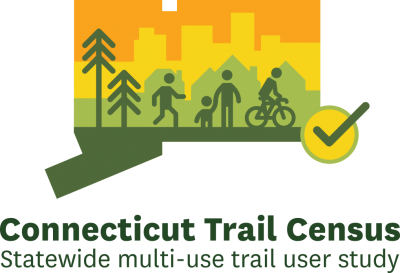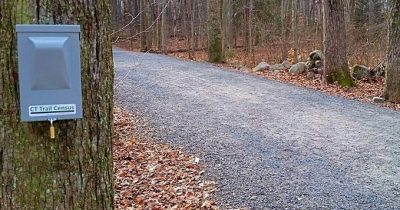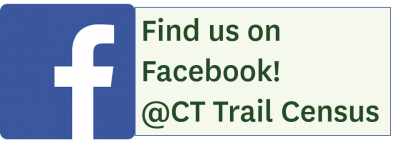
The Connecticut Trail Census is an innovative statewide volunteer-based data collection and education program that encourages data informed decision-making and promotes active citizen participation in multi-use trail monitoring and advocacy. The Trail Census includes trail use counts recorded by infrared pedestrian counters, trail user intercept surveys administered by trained volunteers, and public education programs. The project is statewide and serves community leaders and decision makers including local elected officials, planners, economic development professionals, trail advocates, trail maintenance professionals, environmental, health and outdoor activity advocates, as well as the general public. The program was developed as a partnership program between the University of Connecticut, the Naugatuck Valley Council of Governments, the Connecticut Greenways Council, and local trail advocacy organizations.
What’s this box?

Perhaps you’ve noticed a mysterious grey box with a CT Trail Census decal that has been installed along your trail. The grey electrical junction box houses a Trafx infrared (IR) pedestrian counter that is recording the number of trail users passing it. The counter works by sensing the temperature differential between warm bodies and the ambient air temperature. Every time a trail user passes the counter, the counter records it, enabling project staff to gauge trail use.
The Connecticut Trail Census is a statewide volunteer data collection program intended to inform a better understanding of multi-use trail use in the state of Connecticut and to make this important information available to trail user groups, administrators, government agencies and the general public. The 2017-2018 pilot project is funded by a Connecticut Department of Energy and Environmental Protection Recreational Trails Grant.
Goals of the Connecticut Trail Census
- To understand who is using Connecticut’s multi-use trails when, why and by what means.
- To educate trail user groups, administrators, state and local government agencies, and the general public about trails and their impacts.
- To obtain multi-year information about trail use, user demographics, economic impacts, and trail amenities for identification of patterns and trends.
- To promote active citizen participation in monitoring and understanding the value of trails.
- To encourage sound trail building and maintenance programs based on collected data.
How it Works
Participating trails are paved or stone dust, multi-use, two-way trails. Selected trail groups/organizations:
- Participate in volunteer trainings for infrared counter setup, data retrieval and survey data collection.
- Install and maintain infrared counters (provided), conduct manual calibration counts, and download data quarterly to determine how many and when people are using multi-use trails
- Conduct Intercept surveys (face to face interactions with trail users involving a list of predetermined questions) to understand demographics of trail users including age, gender, location of residence, economic impacts, and needed trail amenities.
- Communicate the results of this data collection to constituents and partners.
The University of Connecticut Center for Land Use Education and Research ensures the collected data will be disseminated freely and openly through interactive maps, data download or interactive data visualization tools. Visit the data portal to interact with the trail use data.
Learn More
For more information about this program, to become a volunteer or to inquire about how your community or trail can be included, contact us at cttrailcensus@gmail.com.
This project is being conducted in a partnership between the Connecticut Greenways Council, Naugatuck Valley Council of Governments (NVCOG), UConn College of Agriculture, Health and Natural Resources – Department of Extension and the Center for Land Use Education and Research (CLEAR), and the CT Department of Energy and Environmental Protection.

